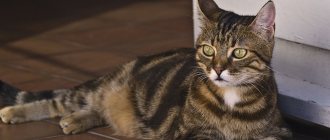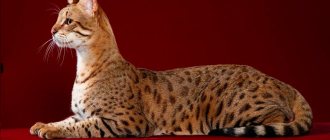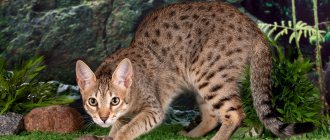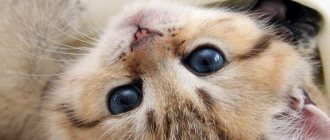History of the Russian Blue cat breed
Russian blue cat
Plush cats began their triumphal march across countries and continents from Foggy Albion, where they gained fame as unrivaled rat catchers. The “grandmother of all Europe,” Queen Victoria, was especially fond of blue-haired cats, at whose court many representatives of this wonderful family lived. History is silent about the routes cats took to reach Shakespeare’s homeland. The British breeders themselves are firmly convinced that their pets came to them from the Russian north, or rather, from snow-covered Arkhangelsk. It was rumored that the first mustachioed “Pomors” were presented to the British by Catherine II, who had the habit of presenting foreign ambassadors with all sorts of living wonders. Apparently, since then, an alternative name has been assigned to the breed - Archangel Blue.
In 1893, British breeder Karen Cox decided to “pump up” the breed qualities of Arkhangelsk cats a little and went to their supposed historical homeland - Pomorie. There the breeder managed to get hold of several kittens, which became the successors of the family of green-eyed “archangels.” As for official recognition, it came to Russian blue cats only in 1912. 19 years after Mrs. Cox’s voyage, felinological associations finally approved a separate standard of appearance for animals, thereby equalizing their rights with representatives of other cat breeds.
After World War II, the Russian Blue cat clan withered and was on the verge of extinction, which greatly alarmed European breeders. Enthusiastic breeders from Britain, Finland, Sweden and Denmark rushed to restore the number of “archangels”. And since finding a sufficient number of purebred individuals for mating turned out to be an impossible task, Russian Blues began to be crossed with representatives of other breeds that had a similar color. So the Arkhangelsk mousecatchers became related, first with the Siamese, and then with the British.
They stopped breeding Russian cats with oriental cats in England quite soon. The reason for stopping the experiments was the inheritance of external defects and behavioral deviations by the offspring. The kittens' character deteriorated, they became too nervous, meowed loudly, and as they grew older, they began to love marking corners. But breeders from the USA were not embarrassed by such transformations and they continued their breeding research. As a result, the American branch of the Russian Blue breed was born, the representatives of which had a pronounced oriental appearance, typical of representatives of the Siamese group.
The Russian Blue cat breed came to Russia during perestroika times. Domestic breeders did not think long about where to get purebred “material” for mating, and began to cross foreign individuals with native cats of the same color and build. The experiment, oddly enough, turned out to be successful, and already in the early 90s, Russian nurseries began to offer the first Arkhangelsk Blue kittens for sale.
The origins of felinology in Russia
However, centralized cat selection and breeding of new cat breeds began in our country only after the collapse of the Soviet Union. The science of felinology in Russia developed only towards the end of the twentieth century. It was during this period that work began on breeding original cat breeds. Despite this, there are still ongoing debates around the world about whether certain breeds belong to Russian selection.
A case in point is the Russian Blue breed. This breed became famous during the reign of Catherine II, in the second half of the nineteenth century. Some researchers claim that this breed was brought to Russia from abroad and was called “foreign blue”. The breed acquired its modern name only later. Other researchers claim that this breed originates from the Arkhangelsk region. Currently, a large amount of work to improve the breed is being carried out in England.
In accordance with the modern classification, the following breeds are distinguished that can be classified as Russian: Siberian, Russian Blue, Neva Masquerade, St. Petersburg and Don Sphynx, Ural Rex, Kuril, Karelian and Mekong Bobtail.
Appearance of a Russian Blue cat
Russian blue kitten
The Russian Blue cat is the embodiment of grace and sophistication. Representatives of this clan are easily identified by their graceful posture and stately “ballet” gait. The second identifying feature of the breed is its dense velvet coats of bluish-ash color. It is thanks to the soft fur, distant from the body, that the silhouette of the animal acquires additional expressiveness and exquisite charm.
Depending on the place of breeding, there are three main types of appearance of Arkhangelsk blues:
- American (TICA standard) - oriental type, characterized by a wedge-shaped skull, large unfolded ears and a double coat of bright blue color;
- European (WCF standard) - with a flat skull and thick coat of a uniform blue tone with a silver tint;
- English (GCCF standard) - with a short wedge-shaped head and dense light blue fur covered with a silvery “patina” (silvering).
Head
According to the standard approved by the World Cat Federation (WCF), representatives of the Russian Blue breed must have a flat, moderately elongated skull and a straight nose, smoothly turning into the same even forehead and forming a slight bulge at the level of the eyebrows. The chin should be strong and rounded. The whisker pads are distinct and moderately convex. The tone of the lobe is gray-blue.
American type Russian Blue cat
European type of Russian Blue cat
English type Russian Blue cat
Eyes
Muzzle of a Russian Blue cat
Large, oval, rich green. Set wide apart.
Ears
Quite large, tilted forward. The tip of the ear looks slightly pointed in “Americans” and more rounded in “Europeans”. The ear tissue is thin and elastic. The inner part of the ear funnel is slightly pubescent.
Neck
The neck of the Russian Blue cat is elongated and graceful.
Frame
The cat's body is muscular, slightly elongated, and medium in size. For American cat breeds, a lightweight (oriental) body type is considered the standard.
Limbs
Legs are long and straight. The Russian Blue's paws are oval, with soft, elastic pads of lilac-pink color. The “Americans” have pinkish-beige pads.
Plush paws
Tail
The cat's tail is long, well-furred, with a rounded tip.
Wool
Mom with kittens
The coat of “Europeans” is short, stands up like a beaver and gives the impression of being very thick due to the equal length of the undercoat and outer hair. American fur coats have a plush texture.
Color
The ideal Russian Blue, from the point of view of the WCF Commission, should have a uniform mid-tone blue color with a slight silver tipping. The TICA standard prescribes a bright blue color type with a subtle silver tint for its pets.
Possible defects
One of the most common defects is a discrepancy between the coat color and the generally accepted standard. For example, even a purebred cat is capable of producing offspring, among whom will be a baby with a spotted coat. The reason for such a marriage is the play of genes, so it is almost impossible to predict the likelihood of the birth of “wrong” kittens.
Serious disadvantages of the breed include a knobby, kinked tail, an incorrect bite, and bulging or too deep-set eyes. Championship is not possible for individuals with a sagging spine, strabismus, or fur that fits tightly to the body. Polydacts, cats that have undergone onychectomy (declaw surgery), animals with color defects (spots on the fur with an area of more than 1 cm) and aggressive individuals are subject to unconditional disqualification.
irbis-mihail_semenov.jpg
Snow leopard.
Photo: Mikhail Semenov In 2010, the Russian Geographical Society supported the grant project “In the Footsteps of the Snow Leopard.” Its goal is to study the state of the snow leopard population, its numbers and age-sex structure, as well as key habitats. These data will help solve the problem of optimizing the territorial protection of this species, as well as the ecosystems of Southern Siberia as a whole. In 2012, the project “In the Footsteps of the Snow Leopard” grew into a full-scale project “Wild Cats of Southern Siberia” to study and preserve rare species of cats in the south of Siberia - snow leopard, manula and lynx.
Manul
The Pallas's cat is a predatory mammal of the cat family, one of the least studied wild cats in the world. Pallas's cat is widespread in Central and Middle Asia, from Southern Transcaucasia and Western Iran to Transbaikalia, Mongolia and Northwestern China. Within Russia, Pallas's cat is found in the Chita region, Buryatia, Tuva and Altai. Included in the Red Books of the Russian Federation, the Trans-Baikal Territory, as well as the republics of Tyva and Buryatia. Manuls can be seen in the Sayano-Shushensky, Khakassky, Daursky nature reserves. The exact number of the species is unknown due to the secretive behavior of the Pallas's cat and the patchy nature of its distribution. Pallas's cat is listed in the Red Book of the Russian Federation, the IUCN Red List and Appendix II of the CITES Convention.
Photo of Russian Blue cat
Personality of the Russian Blue cat
Russian Blue in the arms of the owner
Russian Blue-haired cats can be classified as problem-free pets. Whims, self-will, deliberate sabotage - all this is beyond the understanding of plush aristocrats. Thanks to their innate intelligence and exceptional sensitivity, Arkhangelsk cats give the impression of being somewhat dependent, but one cannot accuse them of being too soft. Russian blue cats are sweet and spontaneous only with their own household. This rule does not apply to strangers and unfamiliar people, so do not be surprised if, upon seeing guests on the threshold, your pet immediately makes a move.
It is believed that representatives of this breed are lenient towards children's pranks and do not lose their composure in situations in which any other cat would have long ago released its claws and issued a battle cry. However, leaving a small child and an animal alone is always an unjustified risk. In relation to other pets, “archangels” are quite loyal. Moreover, cats are ready for a peaceful dialogue with any representative of the fauna, unless he makes attempts to provoke.
The Russian Blue cat’s favorite place is not the owner’s lap or even a well-appointed MDF house, but any piece of furniture at least one and a half meters high, which, like Everest, is subject to immediate (and often repeated) conquest. As for affection, the mustachioed intellectuals accept it quite favorably, but they will not allow themselves to be squeezed to the point of fainting. In addition, in the soul of even the laziest Arkhangelsk cat, a primitive hunter is lightly dozing. This means that getting a mouse or other unwary rodent for a pet is a matter of honor.
In the absence of conditions for full-fledged hunting (applies to individuals living in city apartments), Russian blue cats begin to make do with catching flies and other insects. For this reason, it is not recommended to leave animals in rooms with open windows and balconies. In pursuit of winged prey, pets lose their vigilance and often “fly” outside the apartment, causing injury to themselves.
svetlana-sutyrina-amurskiy-tigr-2.jpg
Amur tiger. Photo: Svetlana Sutyrina
Interesting Facts
- The Amur tiger lives in low mountains, preferring river valleys and wide valleys between ridges, covered with forest.
- The tiger is omnivorous. He can eat both a frog and a bear. However, in the wild, Amur tigers prefer to feed on ungulates: deer, wild boar, roe deer and musk deer. For adequate nutrition, one tiger needs about 50–70 ungulates per year. At the same time, a tiger can eat up to 35 kg of meat in one go.
- A tiger can jump 5 m upward and 10 m long.
- A tiger's tail is a kind of indicator of its mood. When the tiger is calm, the base of its tail is lowered and the end is curved smoothly upward.
- The span of a tiger's whiskers roughly corresponds to the width of its body. Thanks to its whiskers, the predator is able to determine the nature of the surface, temperature, and wind direction. The animal is guided by its whiskers when moving in the dark.
Since 2010, the Russian Geographical Society has supported the Amur Tiger project. Its goal is to study the state of the Amur tiger population and develop scientific foundations for the conservation of the animal. In 2013, on the initiative of the President of the Russian Federation, Chairman of the Board of Trustees of the Russian Geographical Society, Vladimir Putin, the Society became the founder of an autonomous non-profit organization. Its activities focus on the fight against poaching, scientific analysis of the state of the Amur tiger population and ecosystems in the animal’s range, and the organization of educational and educational events.
Far Eastern leopard
The Far Eastern leopard is the rarest subspecies of the cat family on Earth. Currently on the verge of complete extinction. According to various estimates, about 80 individuals live in natural conditions. At the same time, most of the population lives in Russia in the Primorsky Territory and a smaller part lives in China. About 70% of the rare predator's habitat is protected by the Land of the Leopard National Park. In the 20th century, the species was listed in the IUCN Red Book, the Russian Red Book, the IUCN Red List and in Appendix I to the Convention on International Trade in Endangered Species of Wild Fauna and Flora (CITES).
Training and education
Russian blue cats on a leash
If you do not see your pet as a future circus show star, then the only thing you will have to work on with your Russian Blue cat is the ability to use the litter box correctly. By the way, the Arkhangelsk purrs learn this wisdom very quickly, due to their innate passion for cleanliness. It is better to use wood filler for the tray. If the animal was recently adopted from a cattery, buy it the same type of litter that the breeder used.
A kitten should be toilet trained from the first days of its stay in its new home. The baby brought from the nursery is immediately seated in the tray and, stroking, is gently held in it for several minutes. In the first weeks, it is better to limit the pet’s habitat to one room (the kitchen is more suitable). This will make it easier for the kitten to get used to the new place, and the search for a toilet will not take much time.
If desired, the Russian Blue can be taught basic commands (“Come to me!”, “Give me your paw!”). In this case, act as affectionately as possible, alternating short lessons with long rests and tasty rewards.
What not to do:
- tease the animal with finger movements and jokingly fight it with your hands. The Russian Blue cat perceives this behavior as an unspoken encouragement to action, and begins to practice hunting skills in your hands. There are special items for games - “teasers”;
- swing at a pet caught at the “crime scene”, and also spank it. You can express your dissatisfaction with a loud clap of your hands or a newspaper, as well as the command “Ugh!”, pronounced in a stern tone;
- punish the animal retroactively. Russian blue cats are able to draw correct conclusions only in a situation where they are scolded for mistakes made here and now.
Cat acrobat
Cat musician
dalnevostochnyy_leopard_-_mihail_kolesnikov.jpg
Far Eastern leopard.
Photo: Mikhail Kolesnikov Since 2011, the Russian Geographical Society has supported the Far Eastern Leopard project. Its goal is to study the state of predator populations, as well as develop the infrastructure of specially protected natural areas within its range.
In order to preserve the unique natural territories of Russia where the Far Eastern leopard lives, and thus save this subspecies, an autonomous non-profit organization “Far Eastern Leopards” was established in 2011. It cooperates with the Leopardovy Nature Reserve, the Kedrovaya Pad Nature Reserve and the Land of the Leopard National Park, created in 2012.
Irbis, or snow leopard
The snow leopard, or snow leopard, is the only species of the snow leopard genus and the only large representative of the cat family that lives in the highlands of Central Asia. The habitat of the snow leopard lies in the upper and middle zone of the mountains of Central and Central Asia (Himalayas) and Southern Siberia. This range includes the territories of Russia, Afghanistan, Burma, Bhutan, India, Kazakhstan, China, Kyrgyzstan, Mongolia, Nepal, Pakistan, Tajikistan and Uzbekistan. The species is endangered. According to various estimates, about 7 thousand snow leopards live in the wild, while in Russia there are only 150–200 individuals. In the Red Book of the Russian Federation, the snow leopard belongs to category I. This predator is also listed in the Red List of the International Union for Conservation of Nature and in Appendix I of the Convention on International Trade in Endangered Species of Wild Fauna and Flora (CITES). In 2011, the state nature reserve of federal significance “Pozarym” was created, on the territory of which the reintroduction of young snow leopards is carried out.
Care and maintenance
This is not to say that Russian Blue cats require any exceptional care. On the other hand, it won’t be possible to ignore your pet at all, otherwise the animal will lose its outer luster, turning into an unkempt, neglected creature.
Curled up in a ball
With the conditions of keeping, everything is quite simple: plush cats easily take root both in penthouses and in small apartments. If your pet lives in a standard concrete “box,” make him happy by purchasing a play set. Having such “real estate” for personal use, Russian blue cats are less likely to encroach on the surfaces of furniture modules. In addition, it is not forbidden to walk “archangels”: cats relatively easily get used to a harness and behave calmly while walking.
Russian Blue babies are extremely curious and love to explore all the nooks and crannies of their new home. Accordingly, before turning on the washing machine, take the time to make sure that there is no furry explorer sitting in its drum. Serious dangers lie in wires, household chemicals and medications, so it is better to hide all these things from the kitten.
Hygiene
Russian blue cats have an inexplicable craving for water and can be hypnotized by the flow of water from the tap for hours, although frequent bathing is contraindicated for them. A full-fledged “wash” is provided only to very dirty individuals, as well as to individuals preparing for an exhibition. In all other cases, experts recommend using alternative washing using dry shampoo or bran. It is better not to use tinted detergents at all, since after using them the cat runs the risk of losing its aristocratic silvering.
The animal's eyes are examined daily. If contamination is found on the mucous membrane of the eyelid, they should be removed with a napkin or a clean handkerchief. Once a week it is worth checking the condition of your pet's ears. At the same frequency, the oral cavity is examined and the condition of the teeth is assessed.
Once a month, cats have their claws trimmed. It is necessary to cut only the upper, sharp edge of the plate without touching living tissue. If you still have some injuries, treat the wounded area with hydrogen peroxide. In cases where the pet is too resistant to the procedure, it can be extended over several days.
Brush your Russian Blue cat once a week. At the end of the process, go over your pet’s fur with a suede cloth, which will give the “fur coat” a soft shine. Despite the fact that Russian Blues do not shed very intensively, buying a Furminator will not be superfluous. Choose models with short teeth that will help you remove dead hair effectively and painlessly.
Nutrition
The natural diet of the Russian Blue cat is not much different from the menu of the same British cats.
The main foods that plush cats can absorb without compromising their own digestion are poultry fillet, beef, vegetables and dairy products. Buckwheat, rice and oatmeal porridge are also useful. It is better to completely exclude fish from a cat’s diet, but if you still decide to pamper your pet with a forbidden delicacy, do it no more than twice a month. List of prohibited products:
Russian blue cat drinks water
- liver;
- onion and garlic;
- eggplant;
- bones;
- pork and any other fatty meat;
- spicy, spicy and smoked dishes;
- sweets;
- milk.
Among industrial feeds, the best options would be premium and super-premium varieties such as Happy Cat, Royal Canin, Hills, Eukanuba and others. Be sure to study the composition of the “drying”. The color of the fur of Russian Blues is very capricious and can lose its exclusive silvery “patina” if the food contains processed products of sea mollusks and algae. And although such metamorphoses are a temporary phenomenon, it is not recommended to treat a cat with such “drying” before exhibition events. As for the transition from one type of dry food to another, it should be done smoothly, adding a small amount of a new product to the usual diet every day.
Important: experienced breeders advise alternating dry food with wet canned food in a 3:1 ratio. This approach to feeding will provide the animal’s body with a complex of essential vitamins and microelements and will help save on the purchase of mineral supplements.
It is allowed to introduce dry food into the diet of kittens from the age of 2 months, but at first the pet is offered “drying” in a soaked form. Complementary feeding with natural products can begin at the end of the 1st month of life. As an additional source of protein, the baby is given pureed cottage cheese, low-fat pasteurized milk, cheese and cereal porridge with milk.
During the pet’s “meal,” there should be two bowls in front of it: one with food, the second with water, and the latter should remain in the animal’s field of vision around the clock. Even if your mustachioed gourmet prefers a natural diet, he still needs clean, cool water.
How to feed
3-month-old babies are fed 5 times a day. For six-month-old individuals, the number of feedings is reduced to 4. At 9 months, a Russian Blue kitten is considered an adult, so it receives food twice a day.
Toilet
As true perfectionists, Russian Blue cats are very particular about the cleanliness of their litter box. If the catman considers the toilet not “sterile” enough, you have yourself to blame - the fluffy aristocrat will do his “business” in another, more decent, in his opinion, place. Sometimes demonstrative neglect of the tray can signal that the pet is ready for mating. Most often, males are guilty of this. In exceptional cases, puddles on the floor are an expression of the animal’s hidden protest.
Why does the Russian Blue cat change color?
The silver shade of the Russian Blue cat's fur is extremely unstable and depends on external factors. Color changes can be caused by direct sunlight, excess heat (if the cat sleeps on heating devices), as well as poor nutrition. If your pet's diet is oversaturated with iron and copper, this will also immediately affect the color: the cat's coat will darken sharply.
Health and Diseases of the Russian Blue Cat
The life expectancy of the average cat is 15-20 years. In general, representatives of this breed have good heredity and do not suffer from genetic diseases, but they do have a predisposition to diseases of the respiratory organs and digestive system. Most often, “archangels” suffer from gastritis and food allergies. In addition, as cats age, they begin to accumulate excess fat, so it is very important not to overfeed the animal.
Timely vaccination will help prolong your pet's life. In particular, Russian Blues should be vaccinated against calicivirus and herpesvirus infections, rhinotracheitis, chlamydia, rabies, panleukopenia and lichen.
Important: a sick animal must be taken to a veterinary clinic immediately. Do not try to treat Russian blues yourself with pharmaceutical drugs, as is recommended on online forums. At best, such “therapy” will not produce results, at worst, it will aggravate the course of the disease.
rys_-_dmitriy_vahrushev.jpg
Lynx. Photo: Dmitry Vakhrushev
Interesting Facts
- The body length of a male lynx reaches 106 cm, weight – up to 30 kg.
- The lynx is very dexterous: it not only climbs trees and rocks well, but also runs quickly, makes large jumps up to 3.5–4 m, makes long treks, and swims well.
- The objects of lynx hunting are hares, roe deer, musk deer, chamois, aurochs, various birds, rodents, as well as young deer, wild boar, and elk. Hunting through deep snow and crust, the lynx defeats large adult animals.
- The lynx does not touch humans; only a few facts are known that indicate how a wounded lynx attacked people. In her usual state, when meeting a person in the forest, she tries to hide and not show her presence.
- Thanks to the tufts on its ears, the lynx has incredible hearing; it can hear a person’s steps several kilometers away.
How to choose a kitten
When choosing a kitten, focus on its living conditions: the cleanliness of the cage and bedding, whether the animal has toys and water. You can make a discount on a slight “cat” smell in the room. Eliminating the characteristic "orange" in a place where several fertile males live is an almost impossible task.
- Carefully examine the kitten itself. The ideal Russian Blue baby should have green eyes. Do not buy yellow-eyed animals and do not believe the breeder’s sworn assurances that with age the cat’s iris will change its hue to green.
- The fur of 3-month-old kittens should have traces of silvering; be sure to take this fact into account when purchasing. Interspersed with white hairs and spots on the baby’s fur coat are a reason to doubt the seller’s honesty. But there is no need to be afraid of slight “striations” (residual tabby). As the animal matures, this visual effect disappears.
- A healthy kitten should have clean ears and eyes. It is better not to look at individuals running away from you in full sail. This behavior signals instability of the animal’s psyche.
Serious establishments that value their own reputation begin selling kittens from the age of 3 months. Breeders who offer too young individuals simply save on costs because they do not want to feed an extra “mouth.” If you are buying a kitten in another city or country, ask the owner if he can help you with the microchipping procedure and obtaining a travel certificate. Some nurseries provide this type of support at a significant discount as a reward for making a purchase.
By the way, about nurseries. Despite the popularity of the Russian Blue breed, there are not many reliable places in Russia where one could purchase a show- or breed-class animal. It is better and safer to buy a kitten from breeders who, in addition to breeding and selling, are actively engaged in breeding activities. Another important point: the nursery must be registered in one of the felinological systems.
Photo of Russian Blue cat
How much does a Russian Blue cat cost?
The Russian Blue is a fairly popular breed, which could not but affect its price tag.
In addition, it is necessary to take into account the costs of the nursery involved in breeding blue-haired murks. Participation in exhibitions, mandatory vaccinations, mating trips and participation in felinological seminars are not the cheapest pleasures, the cost of which is the sale of kittens. In most domestic nurseries, they charge from 23,000 to 28,000 rubles for a Russian Blue cat kitten. A future champion with an impeccable pedigree will cost around 40,000 rubles. Those who like risk and unhealthy savings can go through virtual bulletin boards, where the price tags for kittens are more pleasant: from 3,500 to 5,000 rubles. For this amount, the buyer has the opportunity to purchase a mixed breed, an animal without documents, or a baby born as a result of an unplanned mating.











